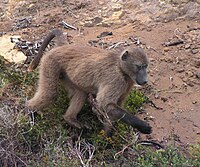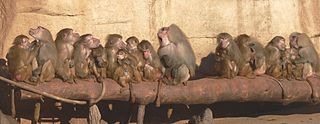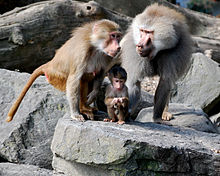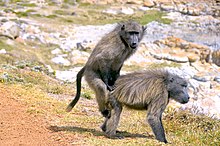Baboons
| Baboons | ||||||||||||
|---|---|---|---|---|---|---|---|---|---|---|---|---|

Anubis baboons ( Papio anubis ) |
||||||||||||
| Systematics | ||||||||||||
|
||||||||||||
| Scientific name | ||||||||||||
| Papio | ||||||||||||
| Erxleben , 1777 |
The baboons ( Papio ) are a primate genus from the family of vervet monkeys (Cercopithecidae). The name baboon first appeared in German-speaking countries in the 15th century as bavian and is borrowed from the Dutch baviaan . It is derived from the old French babine , which means lip or lip and alludes to the protruding snout of the animals; other sources see its origin in the French babouin for fool or little grotesque animal. There is disagreement about the number of species; some authors group all animals into a single species, while others group them into six distinct species.
distribution
Baboons are common over almost all of Africa . As the only primate genus besides humans, it is also found in the northeast of the continent, in Egypt , Ethiopia and in Sudan . They are absent in northwestern Africa and Madagascar . The baboon is also found in Saudi Arabia and Yemen on the Arabian Peninsula ; however, the population there may have been introduced by humans.
features
Males and females of baboons differ considerably in size and often also in shape. Males are almost twice as heavy as females, they have significantly larger canine teeth and, in some species, a pronounced mane in the neck and shoulder area. The tail of the baboon is slightly shorter than the body and curved, the first third pointing upwards, while the remaining part hangs downwards. Baboons reach a head body length of 40 to 110 centimeters and a tail length of up to 80 centimeters. The largest species, the bear baboon , can weigh over 30 kilograms.
Both sexes have a long, dog-like snout, closely spaced eyes, a strong jawbone and a thick, rough coat. The color of the fur varies, depending on the species and gender, from silver in male baboons to yellow ( steppe baboons ) and olive ( anubis baboons ) to brownish, for example in bear baboons . The snout is hairless and colored black or (in the case of the baboon) pink. The buttocks are also hairless; In females there is a pronounced swelling during the fertile period , in which the anus area bulges outwards and often turns bright red.
Way of life
Habitat and locomotion

Baboons are diurnal animals that live in semi-deserts , savannas and steppes as well as in loose forest areas and even in rocky regions. Although they are mostly ground dwellers, they can climb well and like to retire to higher resting places such as trees or cliffs to sleep. On the ground, they move on all fours with their characteristic curved tail. On their forays in search of food, they can cover up to 20 kilometers in a day.
Group behavior
Baboons live in groups of 5 to 250 animals. The size of the group depends, among other things, on the species, the food supply and the availability of sheltered sleeping places on trees or cliffs. There are two different group forms: the mixed groups, in which several males live together with many females, and the one-man or harem groups, in which a single male gathers several females around him.
- The mixed groups are made up of several males and females. Young males have to leave their ancestral group before reaching sexual maturity. The entry into the new group happens through aggressive fights with the already existing males, with which the hierarchy is redefined. Females stay in their group all their life, their ranking is defined by age and relationship (mothers are higher than their daughters). The ranking plays a role, among other things, in mating behavior and access to food resources. Anubis and steppe baboons, for example, live in mixed groups.
- Harem groups are particularly pronounced among robed baboons. The male leads and guards his females and makes sure to always have them close by. With this form, both sexes usually leave their birth group before reaching sexual maturity. Open fights between males for supremacy of an established harem group do occur, but are not the only way for males to get hold of females. Males without a harem sometimes follow a group and try to lure away individual females. Another possibility is that males look for teenage females who have just left their birth group. They look after her, groom her fur, provide her with food, and mate with her once she has reached sexual maturity. Several groups sometimes join together to form larger associations, with the males paying close attention to their females. Conflicts between groups within an association, for example about sleeping places, water holes or food, are resolved by aggressive fights between the males.
Communication and interaction
As highly social animals, baboons can communicate with each other in a variety of ways, including their posture and facial expression, but also through sounds and direct body contact.
- One of the things that counts in communicating through posture is presenting the bottom. This can express both subordination and willingness to mate, for example when a female holds her reddish swollen anal region in front of the male's face. The stare, like the demonstrative yawning and showing of the long canine teeth, is a threatening gesture, whereby the latter is also used against predators.
- Loud statements serve, among other things, to deter or warn against predators and to search for other group members, a deep growl is intended to intimidate the opponent before an argument, aggressive fights are usually accompanied by a high-pitched screeching.
- Mutual grooming plays an important role in the interaction, in which the hierarchy comes to the fore, since above all higher-ranking animals enjoy this treatment by lower-ranking animals. On the other hand, a male can use this method to establish contact with a female and encourage her willingness to mate with him.
Natural enemies
The natural enemies of baboons include leopards , lions , cheetahs and chimpanzees . They show a decidedly aggressive behavior towards predators, several males can inflict severe wounds on their attackers with their long canine teeth if they feel provoked or threatened; people are also affected.
food
Baboons are opportunistic omnivores, but prefer a vegetarian diet. Their food includes fruits, leaves, grasses, seeds, roots, insects and smaller vertebrates. They can snatch prey up to the size of a hare or a monkey , and in rare cases young gazelles. Baboons native to Kenya are also known to chase flamingos at their resting places. In general, they are adapted to nutrient-poor food and can survive even in dry areas that would no longer be suitable for most primates.
Reproduction
Mating behavior
The mating behavior depends strongly on the shape of the group. In mixed groups, any male can mate with any female. The mating order within the male animals depends partly on the hierarchy, especially in times when the females are fertile, the males fight each other bitterly. There are, however, more subtle ways: some males try to win the "friendship" of some females. To do this, they groom their fur, look after their offspring or provide them with food. In fact, some females prefer such “friendly” males when mating. The initiative for mating ultimately comes from the female by presenting his swollen rear part to the male (see normal swelling ).
In harem groups, the males jealously watch over their females, they bite or even chase them when they approach other males. Nevertheless, "cheating" occasionally occurs, for example when single males follow a group looking for a partner. On such occasions there is often aggressive fighting among the males, but some still manage to steal a female from others.
Rearing the young animal
On average every two years the female gives birth to a single young after a gestation period of around six months. This weighs around one kilogram and is colored black. Mainly the females take care of the offspring, not only the mother, but also other animals from the group. In mixed groups, males occasionally worry about the children of “friends” females who are highly likely to be their children; they get them food and play with them. After just under a year, the young are weaned and reach sexual maturity at five to eight years of age. If they leave their birth group, which is the case for almost all animals from harem groups and males from mixed groups, this usually happens before sexual maturity.
The highest known age of a baboon in captivity was 45 years, in the wild, life expectancy is likely to be 30 years.
Hybridization
Baboons of different species living in the same region are often mutually fertile. Often, however, this is only a theoretical possibility: The different social structure prevents, for example, a male anubi baboon from mating with a female baboon; his inability to form and control harems stands in the way. Conversely, however, it has already been observed that male mantled baboons intruded into a group of Anubis baboons, drove away the resident males and forced the females of the strange species into their harems. The offspring from these compounds, in turn, are unable to control harems and adopt the behavior of anubi baboons.
Tribal history and fossil record
Baboons are counted within the subfamily of the pancake monkeys to the tribe of the baboons (Papionini). The genealogical development of this group is controversial. In the past, the mandrill-like ( mandrill and drill ) were considered the closest relatives of the baboons and occasionally even placed in the same genus. More recent studies based on DNA comparisons have turned the suspected relationships in this tribe inside out; the Gelada is seen today as the closest relative of the baboons. The following diagram shows the relationship within the Papionini according to DNA comparison.
| Papionini |
|
||||||||||||||||||||||||||||||||||||
|
|
Several fossil baboon species are known, the most famous of which has the scientific name Papio ingens (sometimes Dinopithecus ingens ). The animal, commonly known as the "giant baboon", was probably the size of a gorilla and lived in eastern Africa during the geological period of the Pleistocene , around 1.7 million years ago. Papio ingens presumably ate foliage and comparable plant food. The oldest baboon is Papio angusticeps , the partially preserved skull of which was found in the South African Malapa cave , where the hominid Australopithecus sediba was found, and was dated to an age of 2.026 to 2.36 million years. The age of this species is before or at the time of the youngest common ancestor of the recent species, whose age was determined to be 1.8 to 2.2 million years with the help of the molecular clock .
species

The six species are closely related to each other. In areas where several species live, there is also mutual reproduction and hybridization , i.e. the offspring of parents of different species. For these reasons, all species are sometimes considered to be just subspecies, and the baboon as such ( Papio hamadryas ) is considered the only species in its genus. More recent studies, for example by Colin Groves from 2001, however, assign all species status. The answer to this question is also related to the Artverständnis because different approaches biological species either fertility ( biospecies ) or based on external characteristics ( morphospecies define). The six types are listed in the following overview:
- The Olive Baboon ( P. Anubis ) is the most widely used baboon. It is characterized by an olive-green fur, which is why it is also called the green baboon.
- The steppe baboon or yellow baboon ( P. cynocephalus ) occurs in eastern and southern Africa.
- The coat baboon ( P. hamadryas ) owes its name to its long hair . Male animals are colored silver-white, females brownish. Its home is northeast Africa and the Arabian Peninsula.
- The Kindapavian ( Papio kindae ) is the smallest baboon species and is found in Zambia and northern Angola.
- The Guinea baboon ( P. papio ) lives in a small area ( Guinea , Senegal , Mauritania , Mali ) in western Africa.
- The largest species is the bear baboon or Tschakma ( P. ursinus ). It has a gray-brown fur and lives in southern Africa.
Baboons and humans
Old Egypt
Mantled baboons were considered sacred animals in ancient Egypt . The god Thoth was sometimes depicted in baboon form. Among other things, Thoth was the god of science and the moon, baboons were depicted accordingly as they taught scribal students. They are also mentioned in the Egyptian Book of the Dead , they sit at the bow of the death barge and the dead turns to them and asks for justice for himself in the realm of the dead. Baboons enjoyed protection and were even mummified after they died.
Other baboon-shaped deities were Babi , who was responsible for sexual ability in the afterlife and was portrayed as a baboon with an erect limb, and Hapi , who acted as a protector of the lungs of the dead and was portrayed as a mummified man with a baboon's head.
San
Bear baboons play a role in the mythology of the San . Legends of this people tell that baboons used to be people who were turned into monkeys as punishment for their evil. There are also petroglyphs of hybrid baboons and humans.
present
Today baboons can often be seen in zoos and nature parks. They are often used in animal experiments . Baboons in the wild are hardly afraid of humans, they often stay near settlements and devastate plantations. There are also reports of them invading villages and snatching smaller pets. Occasionally there are also attacks on people, which lead to bite wounds, for example on the calf.
Due to their adaptability and their large range, they are among the less endangered primates. Two of the six species, the Mantled Baboon and the Guinea Baboon, are classified as low endangered by the International Union for the Conservation of Nature due to the loss of their habitat .
literature
- Thomas Geissmann : Comparative Primatology. Springer-Verlag, Berlin et al. 2003, ISBN 3-540-43645-6 .
- Colin Groves : Primate Taxonomy. Smithsonian Institute Press, Washington DC et al. 2001, ISBN 1-56098-872-X ( Smithsonian Series in comparative evolutionary Biology ).
- Robert M. Sapolsky: My life as a baboon. Memories of a primate. Claassen, Munich 2001, ISBN 3-546-00249-0 .
- Shirley C. Strum: Life Among Baboons. Fifteen years in Kenya. Hanser, Munich 1997, ISBN 3-446-04241-5 .
Web links
- Illustrations of the individual species
- Detailed information on each species (English)
- Phylogeny of Old World Monkeys (PDF file; 2 kB)
Individual evidence
- ↑ WISE, etymological dictionary , Elmar Seebold 23 edition. 1995, ISBN 3-11-012922-1 , p. 618.
- ↑ Baboons vs. Flamingos. Retrieved January 6, 2018 .
- ^ Clifford J. Jolly: Tribe Papionini. Page 157–158 in: Jonathan Kingdon, David Happold, Michael Hoffmann, Thomas Butynski, Meredith Happold and Jan Kalina (eds.): Mammals of Africa Volume II: Primates , Bloomsbury, London, 2013 ISBN 978-1-4081-2252- 5 , page 158.
- ↑ Gilbert CC et al. 2015. Papio Cranium from the Hominin-Bearing Site of Malapa: Implications for the Evolution of Modern Baboon Cranial Morphology and South African Plio-Pleistocene Biochronology. PLoS ONE 10 (8): e0133361; doi: 10.1371 / journal.pone.0133361 .
- ^ Russell A. Mittermeier , Anthony B. Rylands & Don E. Wilson : Handbook of the Mammals of the World: Primates: 3rd page 661, ISBN 978-8496553897 .








